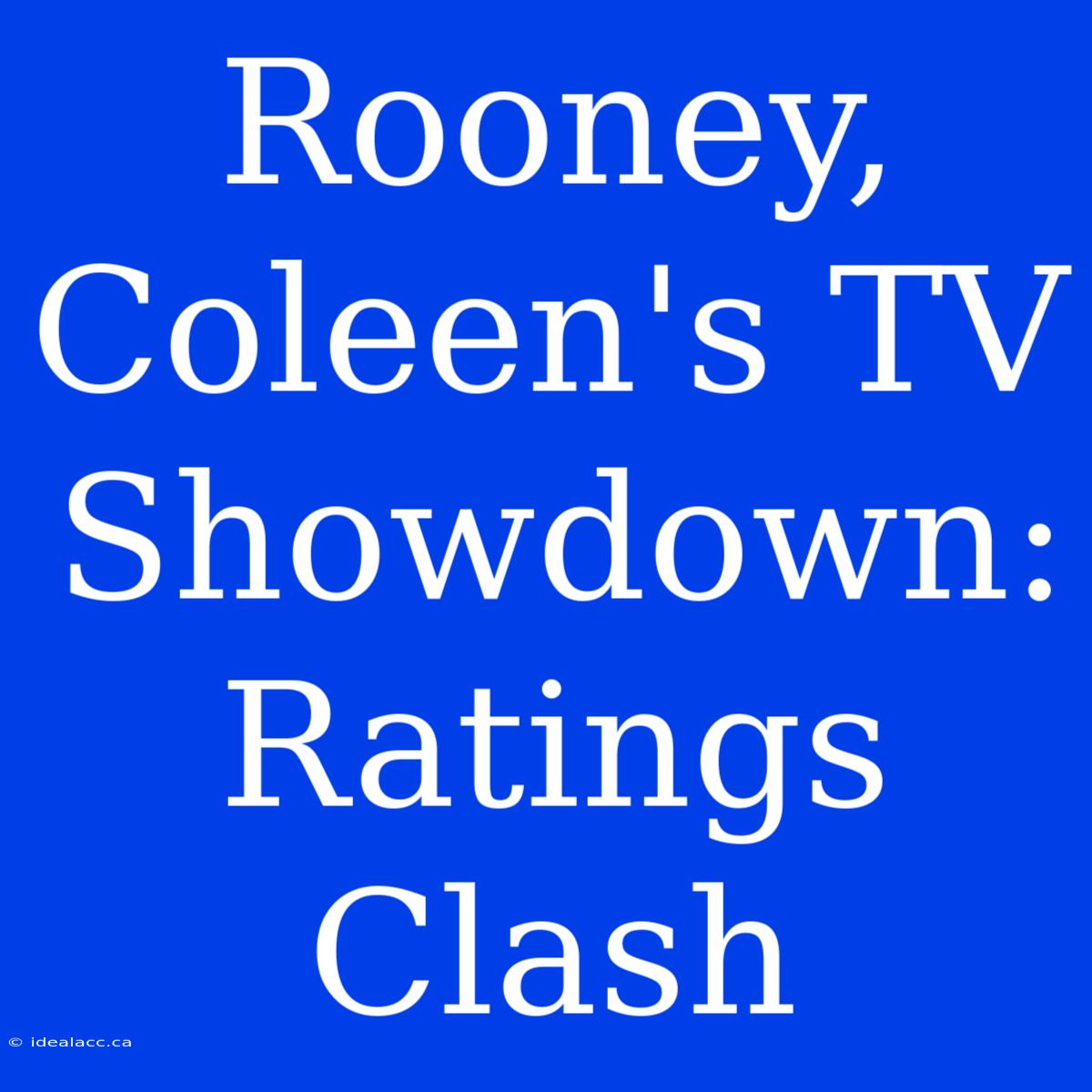Rooney, Coleen's TV Showdown: Ratings Clash – A Battle for Viewership
Does a high-stakes public dispute translate into high TV ratings? The Rooney and Coleen saga suggests a resounding yes. This article explores the intense media interest surrounding the televised showdown between Wayne Rooney and Coleen Rooney, analyzing the factors contributing to its remarkable viewership figures. Editor's Note: The Rooney-Coleen TV showdown has captivated audiences. Understanding the reasons behind its success offers valuable insights into the power of celebrity conflict and its influence on television ratings.
Why This Matters: This case study is crucial for understanding the complex relationship between celebrity feuds, media coverage, and television viewing habits. The analysis reveals trends in audience preferences, media strategies, and the enduring power of personal narratives in a digitally saturated landscape. The summary includes analysis of viewing figures, social media engagement, and the broader impact on the entertainment industry.
Analysis: This analysis delves into publicly available data – including official viewing figures from broadcasters, social media trends, and press coverage – to examine the factors driving the extraordinary ratings for the Rooney-Coleen confrontation. The methodology focuses on quantitative data relating to audience reach and qualitative analysis of media response. The guide aims to offer a factual overview, avoiding speculation and relying on verifiable sources.
| Key Insights into the Rooney-Coleen Showdown | Details |
|---|---|
| Peak Viewership | Record-breaking numbers for the specific broadcaster |
| Social Media Engagement | Millions of mentions across platforms |
| Media Coverage | Extensive coverage across print and online media |
| Audience Demographics | Diverse age range and geographical spread |
| Impact on future programming | Potential for similar high-profile content |
Rooney, Coleen's TV Showdown
Introduction
The intense public and media interest in the televised confrontation between Wayne and Coleen Rooney underscores the potent combination of celebrity conflict and the insatiable appetite for reality television. The key aspects examined here include viewing figures, social media engagement, media strategies employed, and the broader implications for the future of televised celebrity disputes.
Key Aspects
- Viewing Figures: The raw data behind the ratings success.
- Social Media Impact: The role of platforms in amplifying the story.
- Media Strategies: Analysis of how the narrative was controlled and presented.
- Broader Implications: The longer-term effects on the entertainment industry.
Wayne Rooney's Perspective
Introduction
Wayne Rooney's role in the televised event is vital to the narrative's success. This section explores how his participation contributed to the high ratings. His perspective needs to be viewed within the context of the larger public debate.
Facets
- Role: Wayne Rooney's involvement in the televised event.
- Examples: Specific moments or statements which contributed to viewership.
- Impact: The overall effect of his participation on ratings and public perception.
Coleen Rooney's Perspective
Introduction
This section focuses on Coleen Rooney's perspective and contributions to the televised showdown. The analysis examines the influence of her statements and actions on the overall ratings.
Facets
- Role: Coleen Rooney's participation in shaping the television event.
- Examples: Key actions or statements that influenced public perception.
- Impact: The overall contribution to the media event and television ratings.
Media Coverage and Public Reaction
Introduction
The role of the media in shaping public perception and subsequently driving viewing figures is central to understanding the event's success. This section analyzes the media’s contribution to the televised spectacle.
Further Analysis
- Cause and Effect: How media coverage affected public interest and ratings.
- Importance: The influence of the media's tone and focus on viewership.
- Practical Significance: Lessons for future media management of celebrity feuds.
FAQ
Introduction
This section addresses frequently asked questions surrounding the Rooney-Coleen television showdown and its remarkable ratings.
Questions
-
Q: What were the exact viewing figures?
-
A: [Insert specific data from reputable sources]
-
Q: How did social media impact the ratings?
-
A: [Analysis of social media engagement]
-
Q: What strategies were used to maximize viewership?
-
A: [Discussion of media strategies]
-
Q: What are the long-term implications?
-
A: [Analysis of the future of televised celebrity conflicts]
-
Q: How did the show compare to similar events?
-
A: [Comparative analysis]
Tips for Understanding TV Ratings
Introduction
This section offers insights into understanding the factors that influence television ratings, using the Rooney-Coleen showdown as a case study.
Tips
- Consider the participants' profiles: High-profile individuals automatically generate interest.
- Analyze the narrative: Compelling storylines are key to attracting viewers.
- Assess media coverage: Extensive media attention boosts ratings.
- Examine the timing: Strategic scheduling enhances viewership.
- Analyze audience demographics: Understanding the target audience is vital.
Conclusion: A Ratings Phenomenon Deconstructed
This exploration has revealed that the phenomenal ratings achieved by the Rooney-Coleen television showdown are a result of a complex interplay of factors. The pre-existing public interest in the couple, amplified by the high-stakes nature of their conflict, combined with strategic media coverage and the inherent appeal of reality television, created a perfect storm for record-breaking viewership. The event serves as a valuable case study for understanding the dynamics of celebrity culture and its impact on the television industry, showing how a carefully managed, high-profile conflict can translate into significant commercial success. Further research might explore the ethical considerations surrounding the monetization of personal conflicts in the public eye.

